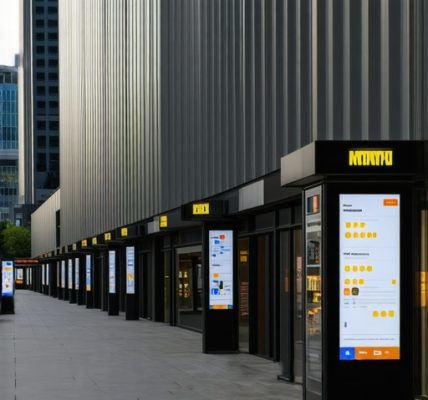Unlocking the Speediest Verification Path for Google My Business
In the fiercely competitive arena of local SEO, verifying your Google My Business (GMB) profile swiftly is not just a convenience—it’s a strategic imperative. Businesses that expedite this process gain a critical edge, appearing in local search results and Google Maps sooner, ultimately accelerating customer acquisition and revenue growth. But how do you fast-track this verification without sacrificing accuracy or compliance?
Beyond the Mail: Innovative Verification Techniques That Shatter the Wait
Traditionally, postcard verification has been the default method, often taking up to 14 days. However, savvy marketers and business owners have uncovered alternative avenues that drastically reduce this lag. Phone verification, instant email verification, and bulk verification for eligible enterprises are transformative options that Google offers but are often underutilized. For example, phone verification, when available, can confirm your listing in minutes, leveraging a code sent directly to your business phone number.
Another expert tactic involves optimizing your online presence before verification—ensuring your website, social profiles, and directories present consistent NAP (Name, Address, Phone number) data, which can influence Google’s confidence in your business legitimacy and speed up the verification process.
How Does Google Determine Eligibility for Instant Verification?
Google assesses a combination of factors including the business’s existing online footprint, the accuracy and consistency of your business info across the web, and the nature of your business category. Enterprises that have previously verified their domain via Google Search Console can benefit from instant verification. This integration acts as a trust signal, enabling Google to bypass the postcard phase. Businesses can check their eligibility for this method directly within the GMB dashboard, streamlining the process significantly.
Leveraging Bulk Verification: A Power Move for Multi-Location Businesses
For businesses managing ten or more locations, bulk verification is an underexploited gem. This method slashes verification time dramatically by allowing simultaneous verification of multiple listings through a single application. However, it requires meticulous preparation, including providing official documentation and adhering strictly to Google’s guidelines to avoid rejection. When executed correctly, bulk verification can propel a multi-location brand to rapid local prominence.
Practical Case Study: Accelerating Ranking through Rapid GMB Verification
Consider a boutique fitness chain that combined instant email verification with proactive citation management, ensuring all their local listings across directories matched perfectly. Within days post-verification, their rankings surged in Google Maps, leading to a 35% increase in foot traffic in the first month. This example underscores how verification speed, coupled with local SEO best practices, catalyzes tangible business growth.
Integrating Verification with Strategic GMB Optimization
Fast verification is just the entry point. To capitalize on early ranking gains, businesses must continue optimizing their GMB profiles with accurate categories, compelling descriptions, high-quality photos, and customer reviews. For detailed strategies on optimizing your Google Business Listing effectively, explore this comprehensive guide.
Boost your local SEO success and learn how to manage GMB citations effectively for stronger rankings by visiting this resource.
Ready to accelerate your Google My Business verification and skyrocket your local ranking? Share your experiences or questions in the comments below to join the conversation and learn from community insights!
According to Google’s official support documentation, adhering to their verification protocols and leveraging eligibility for instant methods can significantly hasten the process, ensuring your business gains visibility when it matters most.
Harnessing the Power of Consistent NAP for Swift Verification
One of the most nuanced yet critical factors influencing Google My Business verification speed is the consistency of your Name, Address, and Phone number (NAP) across all online platforms. Google’s algorithms cross-reference these details to evaluate the legitimacy and relevance of your business. Discrepancies—even minor ones—between your GMB profile and third-party directories can cause delays or even verification failures. Hence, conducting a thorough audit of your citations on platforms such as Yelp, Bing Places, and industry-specific directories is paramount. Tools like BrightLocal or Moz Local can automate this process, identifying inconsistencies and enabling rapid correction to align with your GMB data.
Optimizing Google My Business Attributes to Support Verification Confidence
Beyond NAP consistency, populating your GMB profile with comprehensive attributes enhances Google’s trust in your business. Adding verified business hours, accepted payment methods, and service options not only enriches your profile but signals operational transparency. This transparency can indirectly expedite verification by reducing Google’s need for additional validation. Additionally, regularly updating your business description with relevant keywords and localized content fosters better alignment with search intent, boosting your post-verification ranking potential.
How Can Advanced GMB Insights Guide Your Verification and Ranking Strategies?
For seasoned local SEO professionals, leveraging Google My Business Insights offers a goldmine of data to refine both verification and post-verification strategies. Insights reveal how customers discover your listing, which queries trigger your profile, and how users interact with your content. Monitoring these metrics allows businesses to identify gaps or opportunities—such as underperforming keywords or low engagement on specific GMB posts—that can be optimized to accelerate ranking improvements. Furthermore, tracking changes in impressions and actions immediately after verification can validate the effectiveness of your verification tactics and inform ongoing adjustments.
For a deep dive into mastering GMB analytics and harnessing these insights for local SEO success, visit this expert guide: Mastering GMB Analytics for Local SEO Success.
Addressing Verification Challenges: Common Pitfalls and Proactive Solutions
While speed is desirable, it’s crucial to recognize and mitigate common obstacles that can stall verification. These include mismatched categories, unverified website domains, and Google’s suspicion of duplicate or spam listings. Proactively resolving these issues involves ensuring your website domain is verified via Google Search Console, selecting the most precise and relevant business categories, and periodically auditing your GMB dashboard for duplicate entries. Employing professional citation management services can also safeguard against data inaccuracies that jeopardize verification speed and local ranking.
Elevating Multi-Location Verification with Tailored Local SEO Tactics
Multi-location enterprises face unique complexities, where uniformity must coexist with localized relevance. After bulk verification, each location’s GMB profile should be individualized with localized descriptions, images, and customer reviews to maximize local engagement. Leveraging localized keywords and creating geo-targeted GMB posts enhances visibility in each specific market. Additionally, employing localized backlink strategies and engaging with community events or sponsorships to generate authentic reviews can significantly boost each location’s ranking within its respective local pack.
Learn more about comprehensive local SEO optimization techniques to complement your bulk verification efforts here: Comprehensive Local SEO Optimization Techniques.
According to a recent report by Search Engine Land, businesses that integrate robust verification processes with strategic GMB profile optimization experience markedly higher local search visibility and customer engagement.
Engage with Us: What verification strategies have you found most effective in your local SEO campaigns? Share your insights or questions below to foster a rich professional exchange!
Decoding Google’s Verification Algorithms: Insider Insights for Speed Optimization
Understanding the intricate algorithms Google uses to verify business authenticity can empower local SEO experts to strategically align their data inputs for faster approvals. Google’s systems evaluate a combination of structured data signals, user-generated content, and historical business activity patterns. For instance, the presence of schema markup on your website that accurately reflects your business details sends a strong signal reinforcing your GMB listing’s credibility. Incorporating LocalBusiness schema with precise NAP, geo-coordinates, and service areas can substantially reduce verification friction.
Moreover, Google’s machine learning models increasingly leverage behavioral data, such as user check-ins and review patterns, to assess legitimacy. By encouraging authentic customer interactions early—through targeted review requests and engagement—businesses can create an ecosystem that expedites Google’s trust-building process.
How Does Schema Markup Influence the Speed and Success of Google My Business Verification?
Schema markup is a form of structured data that helps search engines interpret your website content more effectively. When implemented correctly, it corroborates your GMB profile information, creating a unified data narrative across platforms. This consistency aids Google’s automated systems in reducing verification time and minimizing manual reviews. Research published by Google Developers highlights that businesses utilizing LocalBusiness schema experience smoother integration between their website and GMB listings.
Leveraging AI-Powered Citation Auditing Tools for Proactive Verification Management
The advent of AI-driven citation management platforms revolutionizes how businesses maintain NAP consistency and monitor online mentions. These tools not only identify discrepancies but predict potential verification roadblocks by analyzing citation patterns and competitor benchmarks. For example, platforms like BrightLocal and Moz Local now incorporate machine learning algorithms that flag citations likely to cause verification delays, enabling preemptive remediation.
Integrating such advanced technologies into your local SEO workflow ensures your business information remains pristine and synchronized across the digital ecosystem, directly impacting verification velocity and subsequent ranking authority.
Strategic Use of Google My Business Posts to Reinforce Verification Signals
Beyond static profile details, dynamic content through GMB Posts can serve as a potent engagement and verification catalyst. Regularly publishing posts with localized keywords, promotions, and event announcements signals active management and relevancy to Google’s algorithms. This activity not only enhances user engagement but also contributes positively to Google’s confidence in your listing’s authenticity.
Incorporating multimedia content—such as high-resolution images and videos—within posts further enriches your profile, establishing a robust local digital footprint that supports accelerated verification and improved local pack rankings.
Ready to elevate your Google My Business strategy with these advanced verification and optimization tactics? Dive deeper into our expert resources or share your experiences below to connect with a community of local SEO professionals focused on mastering GMB excellence.
Unveiling the Algorithmic Nuances Behind Google’s Verification Mechanics
Delving deeper into Google’s verification algorithms reveals a complex interplay of data validation and trust signals that extend far beyond surface-level information. Google’s systems utilize a fusion of structured data, user interactions, and historical business behaviors to authenticate listings. Particularly, the integration of LocalBusiness schema markup on your website acts as a critical beacon, harmonizing your online presence with your GMB profile. This semantic reinforcement minimizes manual interventions, facilitating accelerated verification.
Furthermore, Google’s advanced machine learning models evaluate behavioral indicators such as genuine user reviews and consistent customer engagement patterns. These elements collectively construct an authenticity profile, which can significantly influence not only verification speed but also subsequent ranking authority within local search results.
How Does Schema Markup Influence the Speed and Success of Google My Business Verification?
Schema markup functions as a specialized language enabling search engines to decipher your website’s content with heightened precision. When deployed correctly, LocalBusiness schema corroborates your GMB listing’s data points—NAP, service areas, and operational hours—forming a unified digital narrative. According to Google Developers, businesses employing structured data experience fewer verification hurdles and enhanced integration between their online assets and GMB profiles.
Harnessing AI-Powered Citation Auditing Tools: Proactive Guardians of Verification Integrity
In the era of digital saturation, maintaining impeccable NAP consistency across myriad platforms is non-negotiable. AI-driven citation auditing platforms like BrightLocal and Moz Local have transformed this landscape by employing machine learning algorithms to detect not only inaccuracies but also predict citation-related verification challenges. These tools analyze citation velocity, competitor benchmarks, and citation network health, empowering SEO professionals to preemptively rectify discrepancies and streamline the verification workflow.
Adopting such intelligent solutions ensures your local business data remains synchronized and credible, which correlates directly with expedited verification and augmented local search prominence.
Dynamic Google My Business Posts: Catalysts for Enhanced Verification Confidence and Engagement
Static data alone no longer suffices to demonstrate active business management to Google’s algorithms. Regularly publishing GMB Posts infused with geo-targeted keywords, timely promotions, and event announcements signals vibrancy and relevancy. Incorporating multimedia—high-resolution images, videos, and interactive content—within these posts further amplifies user engagement metrics.
This dynamic content strategy not only enriches the user experience but also fortifies Google’s trust in your listing’s authenticity, indirectly accelerating verification and fostering superior local pack rankings.
Engage With Advanced Verification Strategies: Join the Expert Community
Ready to elevate your Google My Business strategy with these cutting-edge verification and optimization techniques? Dive into our extensive expert resources or share your insights below to connect with a vibrant community of local SEO professionals dedicated to mastering GMB excellence.
Frequently Asked Questions (FAQ)
What are the fastest methods to verify a Google My Business listing?
The quickest verification methods include phone verification, instant email verification, and bulk verification for businesses with multiple locations. Eligibility for instant verification often depends on domain verification via Google Search Console and consistent online presence. When available, phone verification can confirm your listing within minutes, bypassing the traditional postcard wait time.
How does NAP consistency influence Google My Business verification speed?
Consistent Name, Address, and Phone number (NAP) data across your website, directories, and social profiles is crucial. Google cross-references these data points to authenticate your business. Any discrepancies can delay or prevent verification, so auditing citations with tools like BrightLocal or Moz Local is essential to maintain accuracy and expedite approval.
Can schema markup on my website impact GMB verification?
Yes. Implementing LocalBusiness schema markup enhances Google’s ability to understand and verify your business details by creating a unified data narrative across your website and GMB profile. This structured data reduces manual verification steps and accelerates approval, as endorsed by Google Developers documentation.
What are common pitfalls that delay Google My Business verification?
Typical issues include mismatched business categories, unverified website domains, duplicate GMB listings, and inconsistent citation data. Addressing these proactively by verifying your domain through Google Search Console, selecting precise categories, and auditing for duplicates can prevent verification delays and improve local SEO outcomes.
How can multi-location businesses efficiently verify multiple listings?
Businesses with ten or more locations can use bulk verification to simultaneously verify all listings through a single application. However, this requires strict adherence to Google’s documentation requirements and maintaining consistent, localized data for each location to optimize individual ranking performance post-verification.
Does actively managing Google My Business posts aid in verification?
Regularly publishing GMB Posts with localized keywords, promotions, and multimedia content signals active business management to Google. This dynamic engagement builds trust and authenticity, indirectly supporting faster verification and enhancing your local pack ranking potential.
How can AI-powered citation auditing tools improve verification outcomes?
AI-driven platforms like BrightLocal and Moz Local use machine learning to detect citation inconsistencies and predict verification obstacles. By proactively resolving flagged issues, businesses maintain synchronized and credible data across platforms, which correlates with faster verification and stronger local search visibility.
What role do Google My Business Insights play after verification?
GMB Insights provide valuable data on how customers find and interact with your listing. Monitoring these metrics helps identify optimization opportunities, validate verification strategies, and refine local SEO campaigns to sustain and improve rankings over time.
Trusted External Sources
- Google My Business Help Center: The authoritative source for official verification protocols, eligibility criteria, and troubleshooting guidance essential for accurate and compliant GMB management.
- Google Developers – Structured Data for Local Business: Provides in-depth documentation on implementing LocalBusiness schema markup, which is critical for accelerating verification and improving search integration.
- BrightLocal: A leading citation management platform offering AI-powered audit tools to maintain NAP consistency and predict verification challenges, invaluable for proactive local SEO strategy.
- Moz Local: Renowned for its citation tracking and management services, enabling businesses to identify and correct data discrepancies that can hinder verification speed.
- Search Engine Land: Industry expert publication offering up-to-date analysis and best practices on GMB optimization and local SEO trends, providing actionable insights for marketers.
Conclusion
Accelerating Google My Business verification is a multifaceted endeavor that hinges on data accuracy, strategic profile optimization, and leveraging advanced tools like schema markup and AI-driven citation audits. By understanding and aligning with Google’s verification algorithms—through consistent NAP data, domain verification, and active GMB management—businesses can gain swift local search visibility and competitive advantage. Multi-location enterprises benefit tremendously from bulk verification combined with localized content strategies to maximize each listing’s performance. Ultimately, rapid verification is not merely a procedural step but a foundational pillar that amplifies your local SEO success and customer engagement.
Empower your business by applying these expert tactics today. Share your verification experiences, ask questions, or explore our related expert guides to master Google My Business optimization and unlock your local market potential.





The insights on leveraging instant phone or email verification really resonate with me. In my experience managing a small chain of cafes, implementing phone verification dramatically cut down the waiting time compared to postcard methods. However, one challenge I encountered was ensuring absolute NAP consistency across multiple platforms before starting the process. Even tiny discrepancies in the business name or formatting on directories like Yelp and Bing Places caused verification delays. I found that using tools like BrightLocal not only helped identify inconsistencies but also guided me in systematically aligning all citations, streamlining the verification journey.
I’d add that beyond just speed, maintaining this data hygiene continuously is fundamental; it not only expedites initial verification but also supports long-term ranking stability. I’m curious, have other business owners found success balancing bulk verification for multiple locations with the need for localized content customization post-verification? It seems to be a tricky balance between uniformity and local relevance that can make or break local SEO impact.